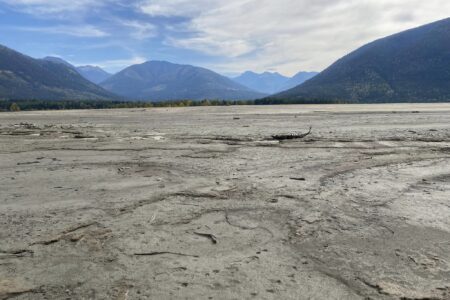How hot was it long ago?
By Andy Soos, ENN
The question seems simple enough: What happens to the Earth’s temperature when atmospheric carbon dioxide levels increase?
It has happened in the past. The answer is elusive. However, clues are hidden in the fossil record.
A new study by researchers from Syracuse and Yale universities provides a much clearer picture of the Earth’s temperature approximately 50 million years ago when CO2 concentrations were higher than today.
The results may shed light on what to expect in the future if CO2 levels keep rising.
The study which for the first time compared multiple geochemical and temperature proxies to determine mean annual and seasonal temperatures, is published online in the journal Geology, the premier publication of the Geological Society of America, and will be published in print on August 1.
SU Alumnus Caitlin Keating-Bitonti is the corresponding author of the study. She conducted the research as an undergraduate student under the guidance of Linda Ivany, associate professor of earth sciences, and Scott Samson, professor of earth sciences, both in Syracuse University’s College of Arts and Sciences.
Early results led the team to bring in Hagit Affek, assistant professor of geology and geophysics at Yale University, and Yale Ph.D. candidate Peter Douglas for collaborative study.
The Eocene epoch, lasting from about 56 to 34 million years ago, is a major division of the geologic timescale and the second epoch of the Paleogene Period in the Cenozoic Era. The Eocene spans the time from the end of the Palaeocene Epoch to the beginning of the Oligocene Epoch.
The start of the Eocene is marked by the emergence of the first modern mammals. The end is set at a major extinction event called Grande Coupure (the “Great Break” ), which may be related to the impact of one or more large bolides in Siberia and in what is now Chesapeake Bay.
The temperature gradient from equator to pole was only half that of today’s, and deep ocean currents were exceptionally warm. The polar regions were much warmer than today, perhaps as mild as the modern-day Pacific Northwest; temperate forests extended right to the poles, while rainy tropical climates extended as far north as 45°.
The difference was greatest in the temperate latitudes; the climate in the tropics however, was probably similar to today’s. The recent discovery of a giant snake in Colombia that may have lived during the Eocene suggests, on the contrary, that the tropics were much warmer than today, a conclusion in accord with numerical simulations of the climate during the Eocene.
Earth’s surface temperatures generally rose from the late Palaeocene through the Early Eocene, reaching maximum Cenozoic temperatures during the Early Eocene Climatic Optimum. Superimposed on this warming were a series of “hyperthermals”.
These are best described as geologically brief (<200 kiloyears) events characterized by rapid warming global warming and massive carbon input to the ocean and atmosphere. The most prominent of these events was the Palaeocene-Eocene Thermal Maximum or Initial Eocene Thermal Maximum (PETM), which began at the Palaeocene-Eocene Boundary.
During this episode. Earth surface temperatures rose by 5-7 °C. The PETM coincided with a major mammalian turnover on, and an extinction of many species in the deep sea.
Previous studies have suggested that the polar regions (high-latitude areas) during the Eocene were very hot—greater than 30 degrees centigrade (86 degrees Fahrenheit). However, because the sun’s rays are strongest at the Earth’s equator, tropical and subtropical areas (lower latitude) will always be at least as warm as polar areas, if not hotter. Until now, temperature data for subtropical regions were limited.
The SU and Yale research team found that average Eocene water temperature along the subtropical U.S. Gulf Coast hovered around 27 degrees centigrade (80 degrees Fahrenheit), slightly cooler than earlier studies predicted. Modern temperatures in the study area average 75 degrees Fahrenheit.
Additionally, the scientists discovered that, during the Eocene, temperatures in the study area did not change more than 3 to 5 degrees centigrade across seasons, whereas today, the area’s seasonal temperatures fluctuate by 12 degrees centigrade.
The new results indicate that the polar and sub-polar regions, while still very warm, could not have been quite as hot as previously suggested.
The findings are based on a chemical analysis of the growth rings of the shells of fossilized bivalve mollusks and on the organic materials trapped in the sediment packed inside the shells, which was conducted by Keating-Bitonti and her colleagues.
Ivany collected the fossils from sediment layers exposed along the Tombigbee River in Alabama.
The mollusks lived in a near-shore marine environment during a time when the sea level was higher and the ocean flooded much of southern Alabama. The sediments that accumulated there contain one of the richest and best-preserved fossil records in the country.
-
“Our study shows that previous estimates of temperatures during the early Eocene were likely overestimated, especially at higher latitudes near the poles,” Keating-Bitonti says. “The study does not mean elevated atmospheric CO2 levels did not produce a greenhouse effect; the Earth was clearly hotter during the early Eocene. Our results support predictions that increasing levels of atmospheric CO2 will result in a warmer climate with less seasonality across the globe.”
- For further information: http://www.syr.edu/news/articles/2011/co2-study-07-11.html























Comments